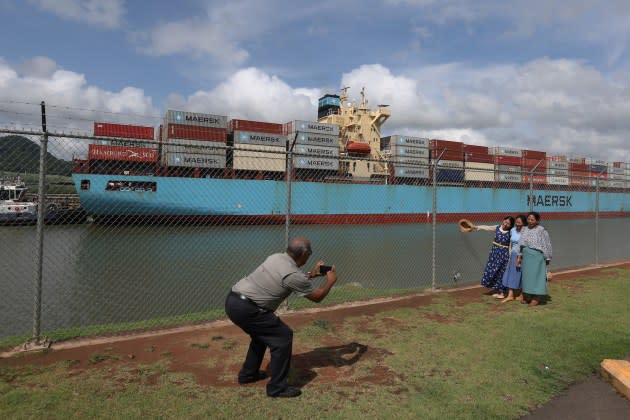Maersk to Bypass Panama Canal Via ‘Land Bridge’

A.P. Moller-Maersk is rethinking how it is approaching the backlogged, drought-stricken Panama Canal with one of its service lines—opting to transport vessels by land instead.
In a customer advisory, Maersk said cargo being transported via the Oceania-to-the Americas “OC1” service, which normally traverses the Panama Canal on its voyage, will now bypass the waterway and use a “land bridge” to transport cargo across the roughly 50-mile country via rail.
More from Sourcing Journal
The Denmark-based shipping and logistics titan said in the advisory that the decision was made to ensure cargo “continues to move with as few delays as possible.”
Sourcing Journal reached out to Maersk. The company has not indicated whether it will extend the land bridge concept to other service lines.
The land bridge would maintain Maersk’s schedule reliability and improve transit times, according to Jonathan Roach, a container market analyst at London-based shipping advisory firm Braemar.
“This is one of many strategies that liner companies have been implementing during this temporary canal restriction,” Roach told Sourcing Journal. “Liner companies are normally very swift and customer-focused to find solutions during times of operational challenges. This is just part of container shipping.”
The modified route creates two separate “loops” on each side of the canal—one in the Atlantic Ocean and another in the Pacific Ocean.
Pacific vessels will turn at Balboa, Panama, to drop off cargo heading for Latin America and North America and pick up shipments on course for Australia and New Zealand. Atlantic ships will turn at Manzanillo, Panama, to offload the freight destined for Australia and New Zealand and collect goods on track for the Americas.
“For a shipper’s perspective, it’s nice to have a clear view of your options,” Peter Sand, chief analyst at Xeneta, told Sourcing Journal. “Currently most options differ from ‘normal’ market conditions by being much more expensive, adding days to the sensitive transit time, and making every shipment more demanding from a execution perspective too.”
Northbound vessels, which make stops at the Ports of Philadelphia and Charleston, S.C., are seeing no delays, Maersk said. However, ships going southbound may experience some delays.
As part of the adjustments, the OC1 route will also avoid its stop in Cartagena, Colombia. Shippers with cargo to route through Cartagena will be served through alternate vessels, according to the ocean freight giant.
The company says it will continue to operate the “PANZ” service that connects the U.S. West Coast to Oceania to provide coverage from both coasts. Additionally, Maersk will connect Gulf Coast ports to the OC1 service in similar ways, but did not elaborate which ports will be added to the route.
Although the land bridge in Panama is one such solution to bypass the congestion, Roach noted that container shipping firms also have the option to discharge cargo at West Coast ports, and move the product from there via rail to the U.S. Midwest and East Coast is another.
“We can expect more outside-the-box thinking in terms of the Panama situation as well as the longer transit times impacting other routings caused by the Suez Canal avoidance, which is ongoing,” Roach said.
Throughout the second half of 2023, the Panama Canal Authority (ACP) imposed multiple rounds of restrictions for shipping firms passing the canal amid the second-driest year on record. The waterway typically accepts 34 to 36 vessels that could be booked ahead of time under normal conditions, but that number dipped to just 22 by December.
Although the daily reservations were expected to be further limited to 18 vessels by February, the canal reversed course, indicating it would accept 24 starting in January.
The restrictions appear to have worked in limiting non-booked vessels.
Overall, 57 vessels are in cue for transit in the Panama Canal as of Thursday morning, with 39 ships having already booked a reservation and 18 having not booked yet. This is down significantly from the 110 total vessels waiting to pass through as of Nov. 30.
But the average time for non-booked vessels in the queue has remained elevated, with northbound ships waiting 9.6 days as of Thursday, nearly doubling the 4.9-day wait time on Dec. 17. Southbound ships are waiting 15.7 days, compared to 6.3 days as of Dec. 17.
The ACP’s restrictions are based on the current and projected levels of the rainfall-fed, artificial Lake Gatun, which provides the water to move ships through the Panama Canal’s lock system. Water levels at the lake were 81.6 feet Thursday, still down more than five feet from the five-year January average of 86.9 feet.
“Without significant rainfall to replenish the Panama Canal and lakes, we can only assume this will go on for a while as liner companies prepare to keep boxes moving by various methods,” said Roach.
